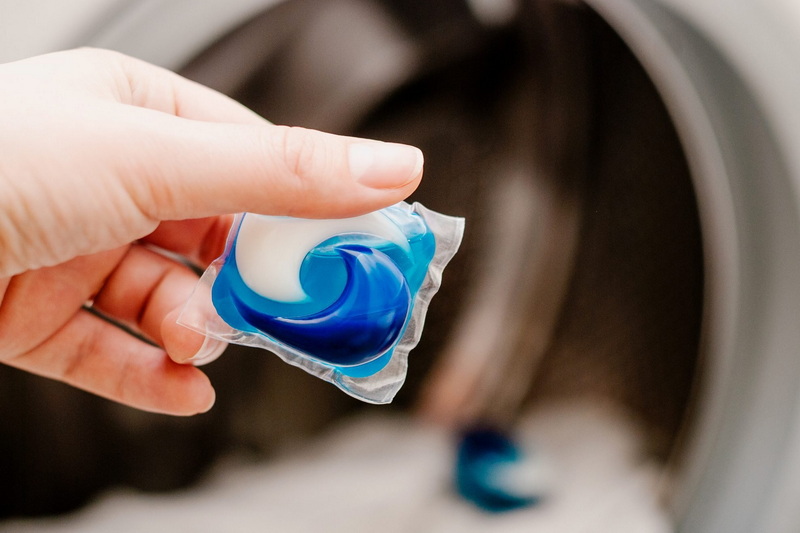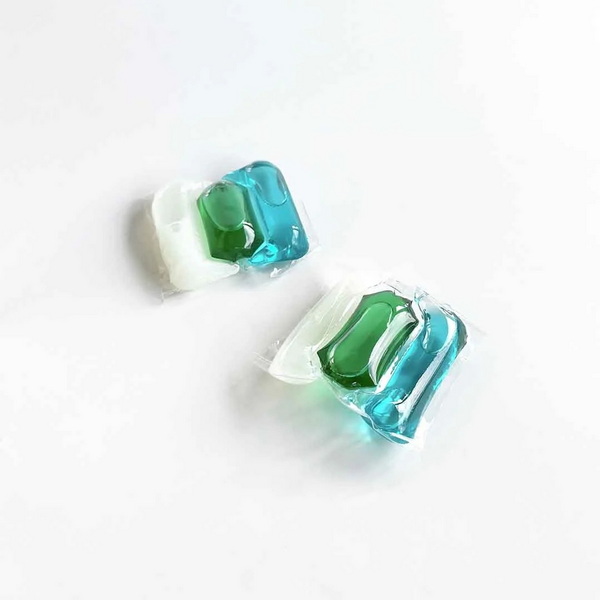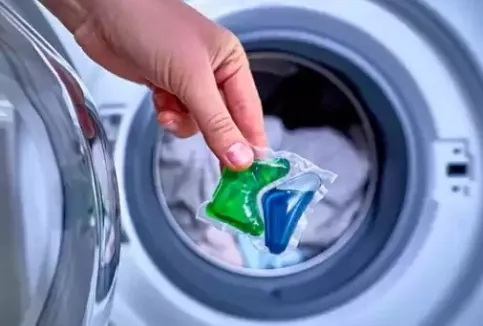Dongguan UFine Daily Chemical Co.,Ltd.
- All
- Product Name
- Product Keyword
- Product Model
- Product Summary
- Product Description
- Multi Field Search
Views: 222 Author: Tomorrow Publish Time: 10-16-2025 Origin: Site











Content Menu
● Understanding Laundry Pods Composition
>> Detergent Ingredients and Environmental Safety
>> Water-Soluble Film and Its Environmental Impact
● Environmental Concerns Related to Laundry Pods
>> Energy and Resource Use in Production
● Advances in Environmentally Safe Laundry Pod Materials
>> Improved Biodegradable Films
>> Eco-Friendly Detergent Formulations
● Proper Usage and Disposal Practices
● Regulatory Framework and Industry Standards
● Future Directions in Sustainable Laundry Pods
● FAQ About Environmental Safety of Laundry Pod Materials
>> 1. Are laundry pod films biodegradable?
>> 2. Do laundry pods contribute to plastic pollution?
>> 3. Are detergent chemicals in laundry pods harmful to aquatic life?
>> 4. How can consumers reduce environmental impact when using laundry pods?
>> 5. Are there any regulations ensuring environmentally safe laundry pod materials?
Laundry pods have revolutionized the way people do laundry, offering convenience and pre-measured doses of detergent. However, concerns about their environmental impact have arisen, particularly regarding the materials used in their production. This article explores whether the materials used in laundry pods are safe for the environment by examining their composition, biodegradability, impact on ecosystems, and potential alternatives.

Laundry pods are small, single-use packets that contain concentrated detergent encased in a water-soluble film. The major components include:
- Detergent Formula: This includes surfactants, enzymes, fragrances, and other cleaning agents.
- Water-Soluble Film: Usually made from polyvinyl alcohol (PVA) or similar polymers, which dissolve in water during the wash cycle.
The detergent inside pods contains surfactants and enzymes designed to break down stains and dirt. Some surfactants, especially older formulations, can be toxic to aquatic life if released into waterways untreated. However, most modern detergents aim to use biodegradable surfactants to reduce environmental harm.
Enzymes used are typically proteins that degrade organic material effectively and are considered environmentally friendly as they break down naturally.
The film encasing the detergent is critical since it dissolves completely in water, releasing the detergent inside the washing machine.
- Polyvinyl Alcohol (PVA) is the most common material. It is water-soluble and biodegradable under certain conditions.
- The biodegradability of PVA depends on sewage treatment systems and environmental factors such as microbial presence and temperature.
- Studies show that PVA can take several weeks to months to break down fully in natural environments, which raises concerns if pods are improperly disposed of.
- In some cases, incomplete degradation may lead to microplastic accumulation, with unknown long-term ecological effects.
Though many detergent components are biodegradable, the concentration in pods can be high. If wastewater treatment is inadequate, residual chemicals and microplastics from pod films could enter rivers and oceans, potentially harming aquatic ecosystems.
Surfactants, phosphates, and fragrances sometimes remain partially untreated in water treatment plants, leading to issues such as algal blooms, oxygen depletion, and toxicity to fish and other marine species.
Pods themselves reduce the need for traditional plastic detergent bottles, potentially lowering plastic waste generation. However, the film in pods, although designed to dissolve, may not degrade fully or quickly in all environments.
- Wastewater treatment plants vary in their ability to break down PVA and similar polymers.
- In areas with poor treatment infrastructure, residues could accumulate.
- Microplastics created by incomplete film degradation pose risks to wildlife and food chains.
Manufacturing laundry pods requires energy and raw materials, including petroleum-derived chemicals. The environmental footprint involves several stages:
- Raw material extraction and processing.
- Production of water-soluble films, which involves chemical synthesis.
- Detergent formulation with complex chemical mixing and enzyme production.
- Packaging and transportation emissions.
- Disposal and waste management challenges.
Although pods reduce plastic bottle waste, the energy and resources needed for their complex manufacturing must be considered when evaluating overall environmental impact.

Recent innovations focus on improving the biodegradability of pod films using:
- Enhanced PVA blending with natural polymers such as starch or cellulose that increase breakdown speed.
- Development of fully compostable films derived from renewable resources like plant-based bioplastics.
- Use of enzymes and microbes to accelerate degradation once pods enter sewage systems.
Enhanced films aim to ensure rapid dissolution not only during washing but also full environmental biodegradation afterward.
Detergent manufacturers are reformulating pods to contain phosphate-free, biodegradable surfactants and natural enzymes, decreasing toxic waste risks. Some brands avoid synthetic fragrances or use essential oils to reduce chemical burden on water systems.
Research is also focusing on low-foaming detergents to conserve water and improve biodegradability while maintaining or enhancing cleaning power.
The environmental safety of laundry pods depends significantly on consumer behavior:
- Using the correct dosage prevents excess chemicals entering wastewater.
- Avoiding discarding pods directly into the environment or sinks reduces pollution.
- Supporting brands that use certified biodegradable materials encourages market shifts toward sustainability.
- Educating consumers on the importance of using pods correctly ensures that the water-soluble film dissolves as intended and minimizes waste.
- Some manufacturers are developing refill packs or reusable packaging to further reduce waste.
Many countries regulate detergent components and packaging, encouraging biodegradability and limiting harmful substances in pods. Examples include:
- Restrictions on phosphates and certain surfactants known to be toxic to aquatic life.
- Requirements for biodegradability tests on pod films.
- Certification schemes like OEKO-TEX, EPA Safer Choice, and EU Ecolabel to verify safer, eco-friendly materials.
Regulatory compliance drives manufacturers to innovate and improve the environmental profile of laundry pods continually.
Improvements are ongoing in the following areas:
- Developing films that dissolve quickly at low water temperatures and biodegrade completely.
- Utilizing green chemistry principles for detergent ingredients sourced from renewable materials.
- Expanding consumer education campaigns to reduce misuse and improper disposal.
- Investing in wastewater treatment technologies better able to degrade complex polymers and remove detergent residues.
- Creating circular economy models for detergent packaging and materials.
The materials used in laundry pods are generally becoming safer for the environment due to advances in biodegradable films and eco-friendly detergent formulas. However, challenges remain in ensuring complete biodegradability of pod films, preventing chemical pollution, and promoting responsible usage and disposal. As technology advances and regulations tighten, laundry pods can become an environmentally conscious choice when combined with sustainable consumer habits. Ultimately, minimizing environmental impact requires cooperation among manufacturers, regulators, wastewater treatment systems, and consumers.

Yes, most laundry pods use polyvinyl alcohol (PVA) films which are water-soluble and biodegradable under certain conditions, but complete breakdown may take weeks to months depending on the environment.
While laundry pods reduce plastic bottle usage, their films can contribute to microplastic pollution if not properly degraded in wastewater treatment systems.
Some traditional surfactants can be harmful, but many modern pod formulations use biodegradable and less toxic detergents to minimize environmental risks.
Using the correct pod dosage, avoiding disposal of pods outside washing machines, and choosing pods with eco-friendly certifications can significantly reduce environmental harm.
Yes, various countries have regulations controlling detergent composition and biodegradability requirements, and certifications exist to verify safer, eco-friendly pod materials.